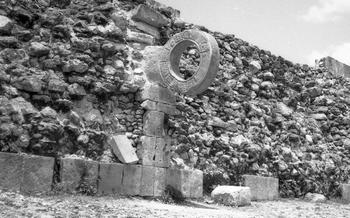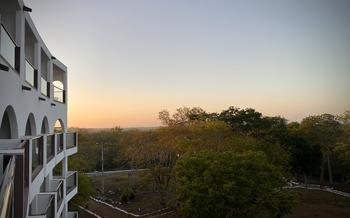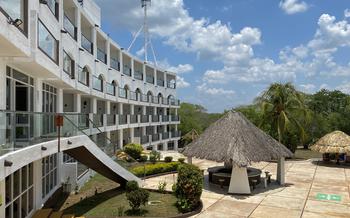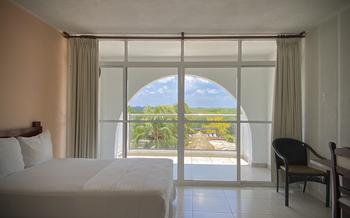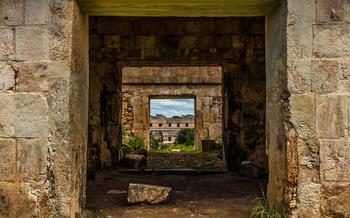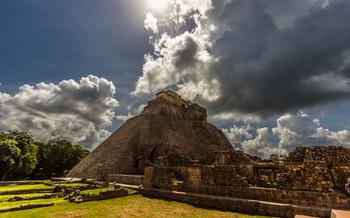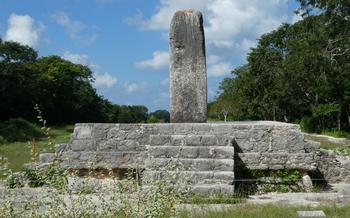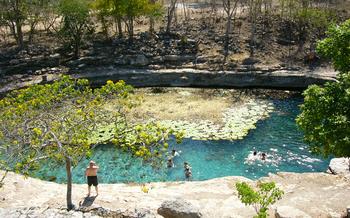
Dzibilchaltún Ruins
- The Wonder of Dzibilchaltún
- A Journey Through Time
- Unveiling the Sacred Cenote Xlacah
- Exploring the Temple of the Seven Dolls
- The Governor's Palace: A Glimpse into Mayan Leadership
- The Arch of Triumph: A Gateway to the Past
- The Great Platform: A Monumental Foundation
- Unlocking the Mysteries of the Glyphs
- Immerse Yourself in the Maya Museum:
- Strolling Through the Lush Gardens
- Transportation Options
- Where to Stay:
- Insider Tip: Enhancing Your Dzibilchaltún Experience:
The Wonder of Dzibilchaltún
Dzibilchaltún, a mesmerizing Maya city, lies just north of Mérida, inviting you on a journey through time and culture. Its historical significance and archaeological importance are undeniable, making it a must-see attraction for any traveler seeking to delve into the depths of the Maya civilization. Easily accessible from Mérida, Dzibilchaltún stands as a testament to the ingenuity and artistry of the Maya people, showcasing their architectural prowess and offering a glimpse into their rich cultural heritage. Prepare to be captivated as you explore this ancient city, where every stone holds a story and every ruin whispers of a once-thriving civilization.
A Journey Through Time
Dzibilchaltún, once a bustling Maya city, stands as a testament to the rich cultural heritage of the region. Its occupation spanned centuries, with the earliest settlements dating back to 500 BC. During the Classic period (250-900 AD), the city reached its peak, flourishing as a major center of trade and commerce. The Maya constructed magnificent structures, leaving behind a legacy of architectural wonders that continue to captivate visitors today.
The city's layout reflects the Maya's deep understanding of urban planning. The central plaza, surrounded by temples, palaces, and other civic buildings, served as the heart of the city. The residential areas extended outward, with houses arranged in orderly rows along well-defined streets. This organized layout not only facilitated efficient movement within the city but also showcased the Maya's advanced engineering skills.
The Pre-Columbian architecture of Dzibilchaltún is a testament to the Maya's ingenuity and craftsmanship. Their mastery of construction techniques is evident in the intricate stone carvings, corbelled arches, and vaulted ceilings that adorn the city's buildings. These architectural achievements not only served practical purposes but also held deep symbolic and religious significance, reflecting the Maya's beliefs and way of life.
Unveiling the Sacred Cenote Xlacah
Nestled within the heart of Dzibilchaltún lies a natural wonder of immense significance: the Sacred Cenote Xlacah. This ancient sinkhole, with its crystal-clear waters, served as a vital source of water for the Maya inhabitants and held profound religious and ceremonial importance.
The Maya believed that cenotes were gateways to the underworld, Xibalba, and that their waters possessed sacred and mystical powers. Rituals and ceremonies were frequently conducted at the cenote, with offerings made to the Maya rain god, Chaac, in hopes of ensuring a bountiful harvest and favorable weather conditions.
The Cenote Xlacah is a testament to the Maya's deep connection to nature and their belief in the interconnectedness of the physical and spiritual realms. Its serene beauty and tranquil atmosphere invite visitors to pause, reflect, and immerse themselves in the rich history and traditions of the ancient Maya civilization.
Exploring the Temple of the Seven Dolls
Amidst the ruins of Dzibilchaltún, the Temple of the Seven Dolls stands as a testament to the architectural prowess and religious beliefs of the ancient Maya. Excavated in 1956, this remarkable structure derives its name from the seven identical ceramic dolls found within its sanctum. These intricately crafted figurines, each adorned with elaborate headdresses and necklaces, are believed to have represented important Mayan deities or ancestors.
The temple itself is a marvel of precision and symmetry, showcasing the advanced engineering skills of the Maya. Constructed using the corbelled arch technique, it features a series of interconnected chambers and passageways, creating a labyrinthine layout that adds to its allure. The interior walls are adorned with intricate carvings and bas-reliefs, depicting scenes from Mayan mythology and daily life, offering a glimpse into the rich cultural heritage of this ancient civilization.
In addition to its architectural significance, the Temple of the Seven Dolls holds immense religious importance. The discovery of the ceramic dolls within the sanctum suggests that the temple was likely a sacred space dedicated to religious rituals and ceremonies. It is believed that the dolls served as intermediaries between the Maya and their gods, acting as vessels for prayers and offerings.
The excavation of the Temple of the Seven Dolls has provided invaluable insights into the religious practices and beliefs of the ancient Maya. It stands as a testament to their ingenuity, creativity, and deep connection to their spiritual world.
The Governor's Palace: A Glimpse into Mayan Leadership
Amidst the sprawling ruins of Dzibilchaltún, the Governor's Palace stands as a testament to the power and authority of the ancient Maya rulers. This impressive structure served as the administrative center of the city, where leaders governed, conducted ceremonies, and oversaw the daily affairs of their people.
The Governor's Palace is a complex of several interconnected buildings, each with its own unique function. The main building, known as the Governor's House, features a large central hall flanked by smaller rooms. This hall was likely used for official meetings, ceremonies, and the administration of justice.
The Governor's Palace is a remarkable example of Pre-Columbian architecture, showcasing the advanced engineering and construction skills of the Maya. The use of corbelled arches, vaulted ceilings, and intricate stone carvings demonstrates the architectural prowess of this ancient civilization.
While the Governor's Palace has undergone significant restoration efforts, it retains its original charm and grandeur. Visitors can explore the various chambers, marvel at the intricate carvings, and immerse themselves in the history and culture of the ancient Maya.
The Arch of Triumph: A Gateway to the Past
Amidst the captivating ruins of Dzibilchaltún stands the Arch of Triumph, an iconic landmark that has stood the test of time. This impressive structure, estimated to have been built between 500 and 600 AD, served as a grand entrance to the ancient Maya city. Its architectural prowess and historical significance make it a must-see attraction for any visitor exploring the wonders of Dzibilchaltún.
Constructed from massive limestone blocks, the Arch of Triumph rises proudly, showcasing the remarkable engineering skills of the ancient Maya. Its imposing presence and intricate carvings captivate the imagination, transporting visitors back to a time when this city thrived as a bustling center of commerce and culture.
The arch features a corbelled vault, a technique commonly used in Maya architecture, which creates a sense of height and grandeur. Its façade is adorned with intricate carvings depicting various symbols and figures, offering a glimpse into the rich iconography and symbolism of the Maya civilization.
Beyond its architectural significance, the Arch of Triumph holds immense historical value. It stands as a testament to the grandeur and power of the ancient Maya, who built this impressive structure as a symbol of their authority and influence. Today, it serves as a gateway to the past, inviting visitors to step back in time and explore the fascinating world of this ancient civilization.
The Great Platform: A Monumental Foundation
Among the many impressive structures at Dzibilchaltún, the Great Platform stands out as a testament to the Maya's architectural prowess and engineering capabilities. Towering over the surrounding landscape, this colossal platform is the largest in the entire site, covering an area of approximately 150 by 150 meters. Its sheer size and grandiosity evoke a sense of awe and wonder, leaving visitors in awe of the Maya civilization's accomplishments.
The Great Platform served as a foundation for various important structures, including temples, palaces, and administrative buildings. Its elevated position provided a commanding view of the city, allowing the Maya elite to oversee and manage their domain effectively. The platform's strategic location also suggests that it played a significant role in religious ceremonies and rituals, as it offered a sacred space for the Maya to connect with their gods and ancestors.
The architectural design of the Great Platform showcases the Maya's mastery of construction techniques. Built using large limestone blocks, the platform features a series of terraces and staircases that lead to the summit. The terraces are adorned with intricate carvings and sculptures, depicting various Maya deities and mythological scenes. These decorative elements provide valuable insights into the Maya's beliefs and cultural practices.
The Great Platform stands as a testament to the Maya's ingenuity and their ability to create monumental structures that have withstood the test of time. Its impressive size, architectural details, and historical significance make it a must-see attraction for anyone visiting Dzibilchaltún.
Unlocking the Mysteries of the Glyphs
The Maya civilization left behind an intricate writing system that continues to captivate scholars and visitors alike. Dzibilchaltún is home to numerous stelae and inscriptions, offering valuable insights into the Maya culture and history. These carved stone monuments feature intricate glyphs, representing a complex system of writing that combines logographic and syllabic elements. Deciphering these glyphs has been a challenging endeavor for researchers, but their efforts have shed light on the Maya's sophisticated understanding of astronomy, mathematics, and religious beliefs. As you wander through the ruins, keep an eye out for these fascinating inscriptions, each one a testament to the intellectual achievements of the ancient Maya.
Immerse Yourself in the Maya Museum:
Delve into the captivating world of the Maya civilization at the on-site museum within the Dzibilchaltún ruins. This treasure trove of artifacts and exhibits unveils the rich cultural heritage and traditions of the ancient Maya people. Admire intricate pottery, finely carved sculptures, and fascinating inscriptions that provide glimpses into their daily lives, religious beliefs, and artistic prowess. The museum serves as a valuable educational resource, offering insights into the history, culture, and achievements of this remarkable civilization. Don't miss the opportunity to immerse yourself in the captivating stories and mysteries of the Maya at this exceptional museum.
Strolling Through the Lush Gardens
Amidst the awe-inspiring ruins of Dzibilchaltún lies an enchanting oasis, a sanctuary of tranquility and natural beauty—the lush gardens. Step into this verdant paradise, and you'll be greeted by a symphony of colors, textures, and fragrances that will transport you to a realm of serenity.
The gardens are a testament to the Maya's deep connection with nature. Stroll along the winding paths, and you'll encounter a diverse array of native flora, each with its own unique story to tell. Marvel at the towering trees that reach towards the sky, providing a canopy of shade from the tropical sun. Admire the vibrant flowers that bloom in profusion, painting the landscape with hues of red, yellow, and purple.
Take a moment to pause and listen to the sweet melodies of the birds that flit among the branches. Inhale the intoxicating scent of the flowers, carried by the gentle breeze. Let the tranquility of the gardens wash over you as you reconnect with the natural world.
Whether you're seeking a moment of solitude or a peaceful retreat, the gardens of Dzibilchaltún offer a sanctuary for the soul. Immerse yourself in the beauty of nature, and let the spirit of the Maya guide you on a journey of rejuvenation and serenity.
Transportation Options
Renting a Car: For the ultimate freedom and flexibility, renting a car is an excellent option. Explore the region at your own pace, stopping at additional attractions and charming towns along the way. Ensure you have a valid driver's license and are comfortable navigating unfamiliar roads.
Taking a Taxi or Uber: Taxis and Uber are widely available in Mérida and can be a convenient way to reach Dzibilchaltún. Agree on a fare or confirm pricing through the app before embarking on your journey.
Joining a Guided Tour: Guided tours offer a hassle-free and informative experience. Let knowledgeable guides lead you through the ruins, providing insights into the history and significance of each site. Choose from various tour options, including group tours, private tours, and day trips that combine visits to multiple attractions.
Public Transportation Availability: Public transportation to Dzibilchaltún is limited. Buses depart from Mérida's main bus terminal, but the journey can be lengthy and involve multiple transfers. Consider this option only if you have ample time and are comfortable navigating local transportation systems.
Where to Stay:
When planning your visit to Dzibilchaltún, you'll want to find comfortable and convenient accommodations nearby. Several hotels and guesthouses are located within a short distance of the ruins, offering a range of options to suit different budgets and preferences.
For a luxurious and immersive experience, consider staying at the Hacienda Xcanatún, a beautifully restored 17th-century hacienda that offers elegant rooms, a swimming pool, and a restaurant serving traditional Yucatecan cuisine.
For a more budget-friendly option, the Hotel Maya Dzibilchaltún is a solid choice, providing clean and comfortable rooms at an affordable price. The hotel features a swimming pool, a restaurant, and a bar, making it a great place to relax and unwind after a day of exploring the ruins.
No matter where you choose to stay, be sure to book your accommodation in advance, especially if you're visiting during the peak tourist season. This will ensure that you have a place to stay and can fully enjoy your time in Dzibilchaltún.
Insider Tip: Enhancing Your Dzibilchaltún Experience:
To truly immerse yourself in the magic of Dzibilchaltún, venture beyond the main attractions and explore the hidden gems that often go unnoticed. Discover secluded cenotes tucked away in the lush vegetation, each offering a unique swimming and snorkeling experience. Pack comfortable shoes to navigate the uneven terrain and bring ample water and sunscreen to stay hydrated and protected under the tropical sun. Indulge in the delectable local cuisine, savoring the flavors of traditional Maya dishes that have been passed down through generations. Finally, make an effort to learn a few basic Maya phrases to connect with the local community and deepen your appreciation for the rich cultural heritage of the region. These insider tips will elevate your visit to Dzibilchaltún, ensuring an unforgettable and enriching journey into the heart of the ancient Maya world.
